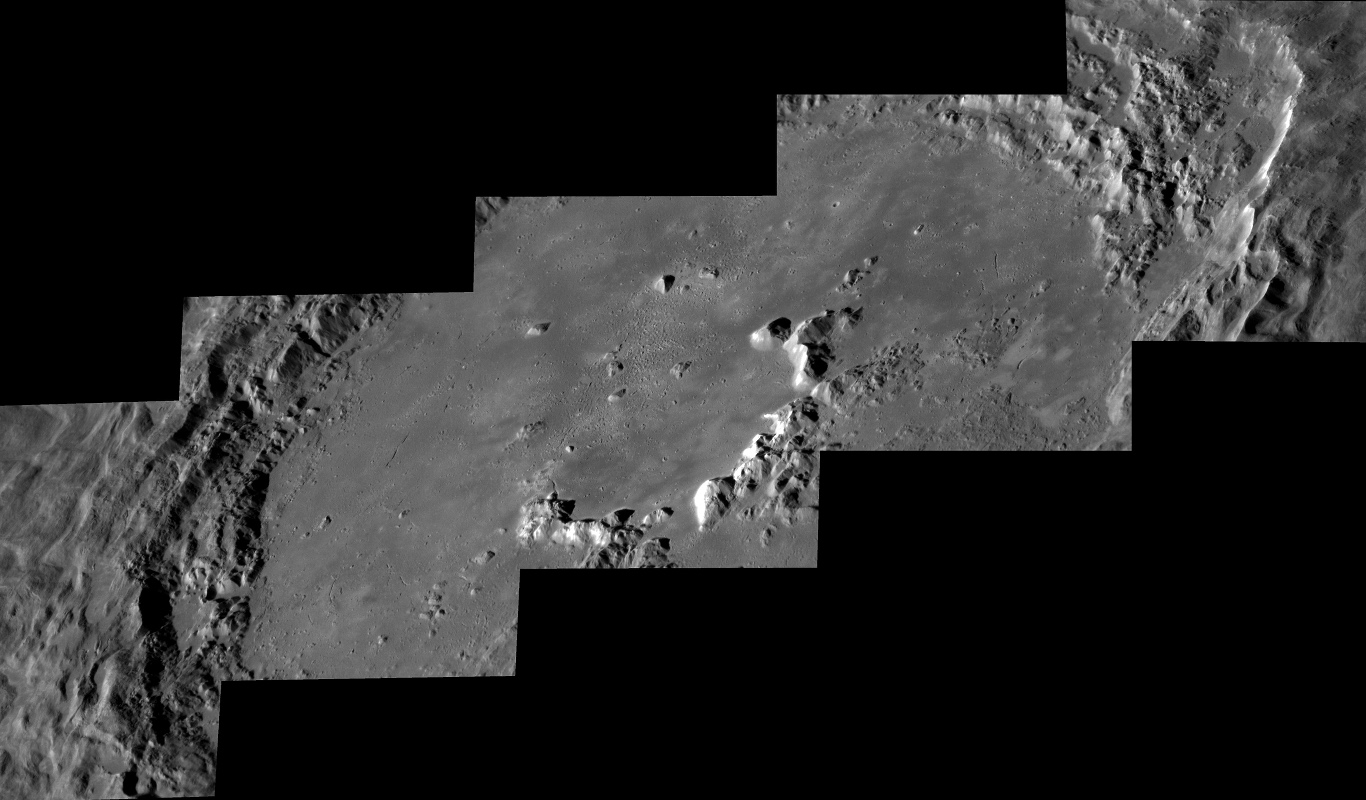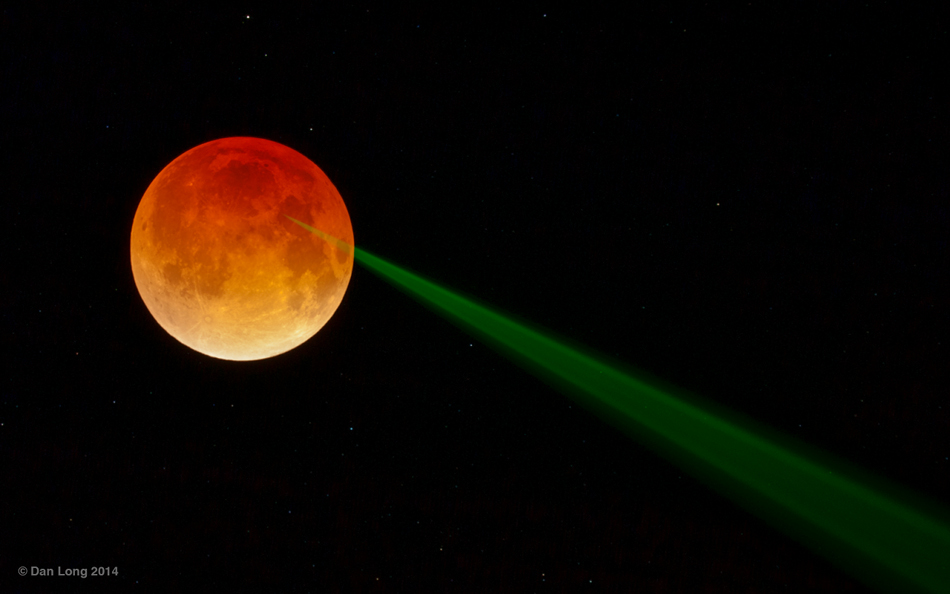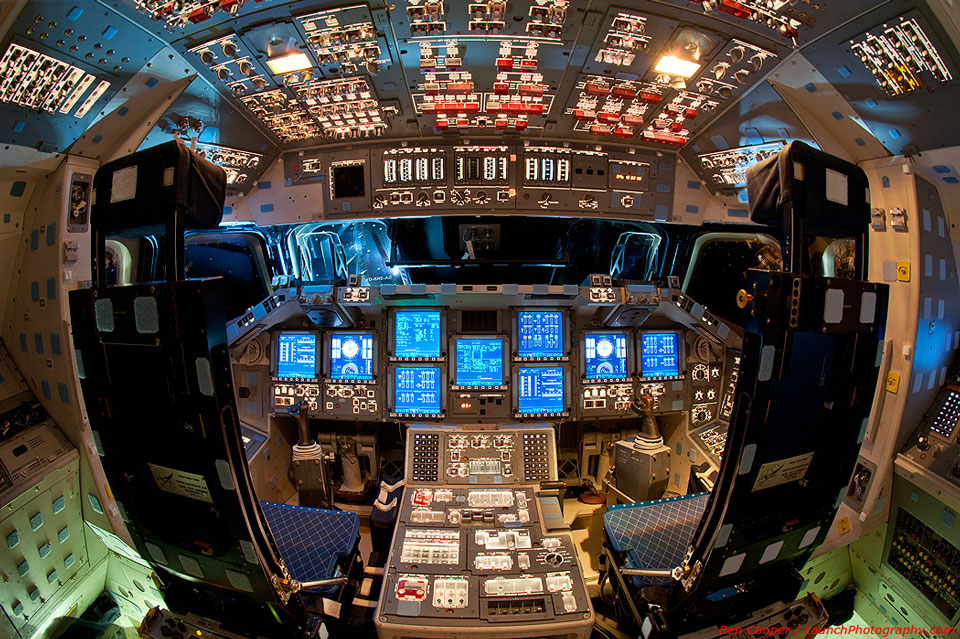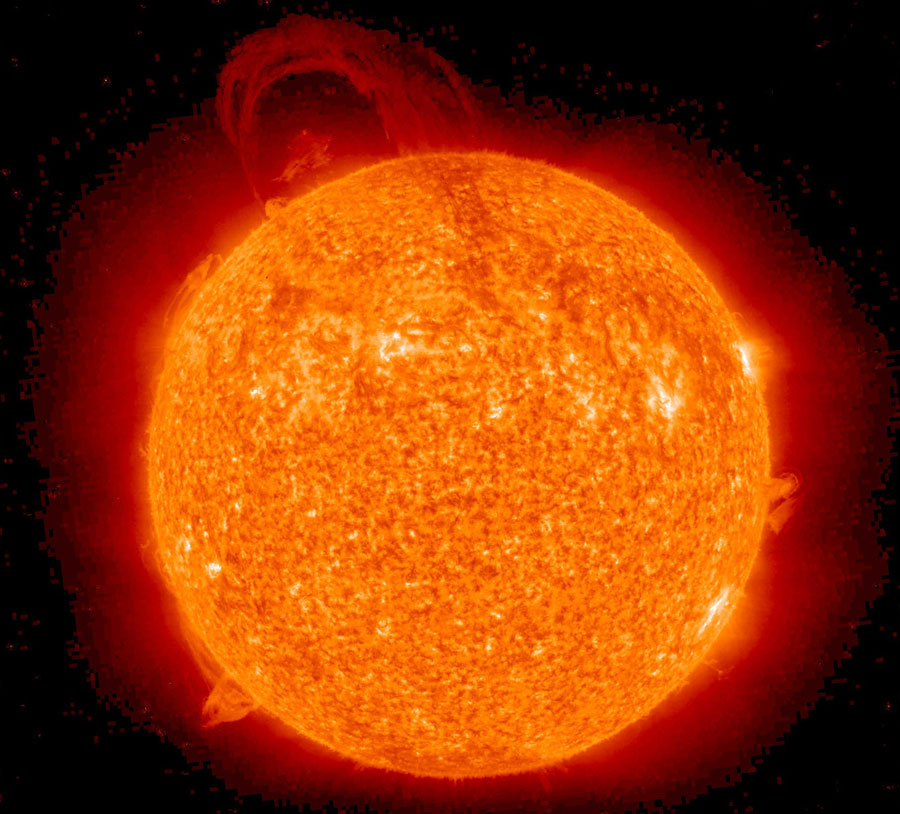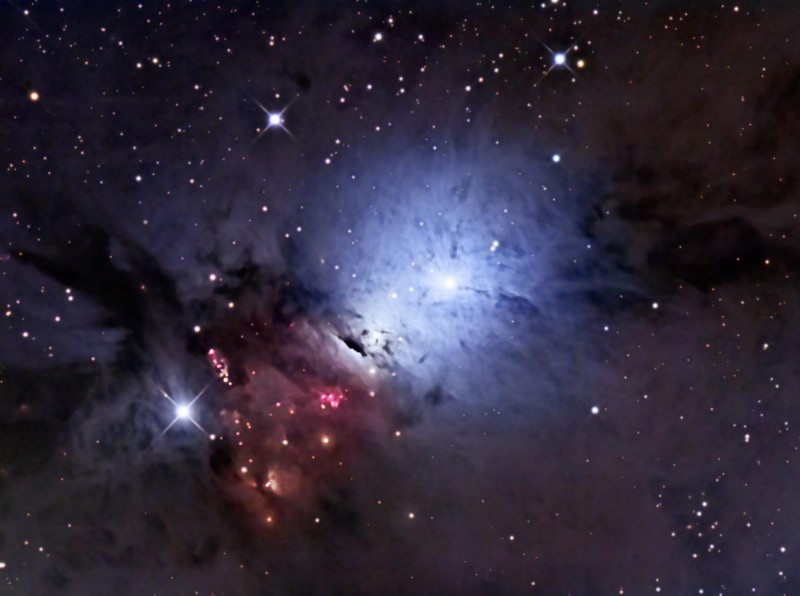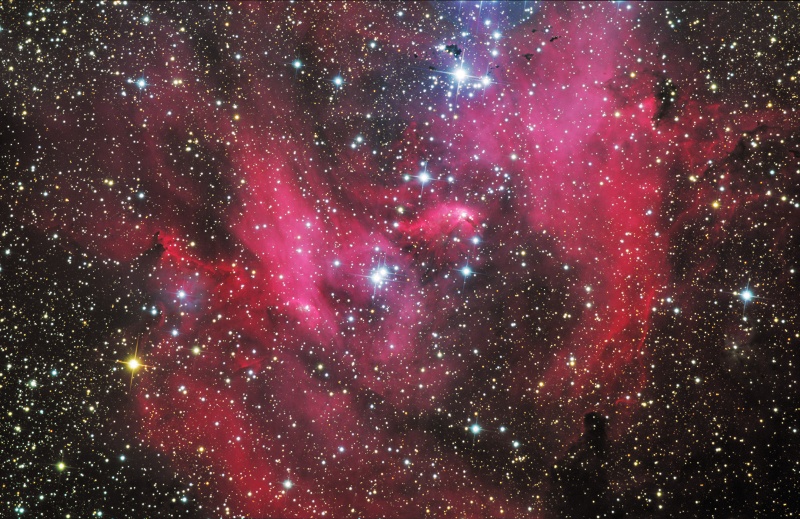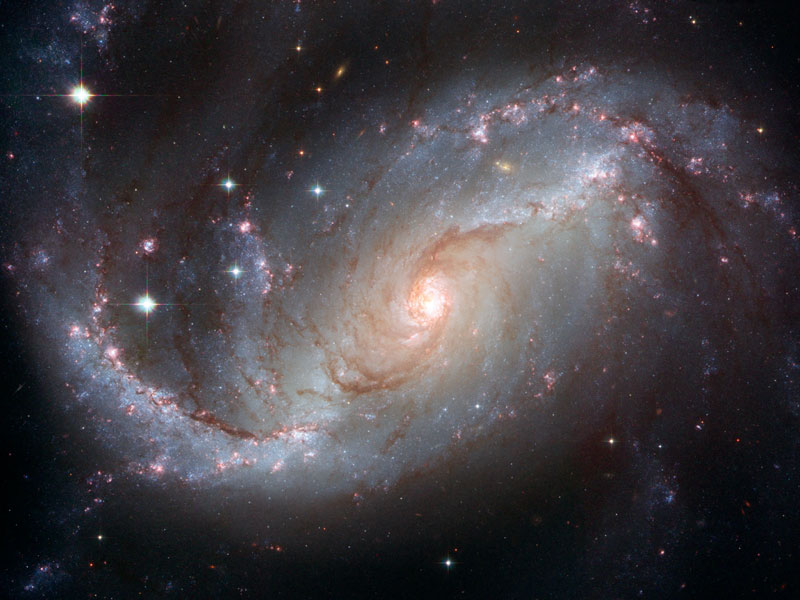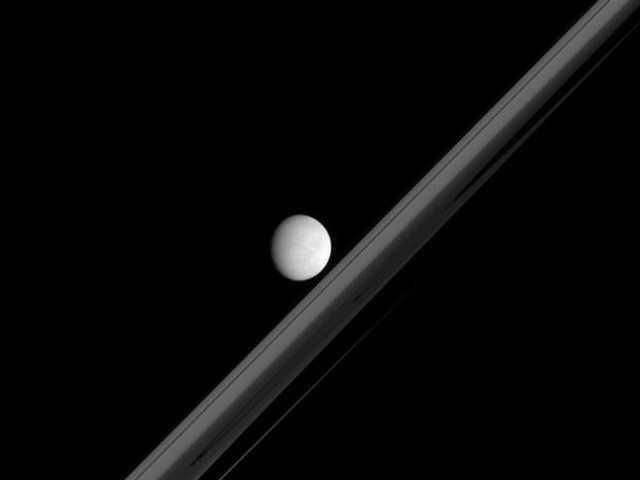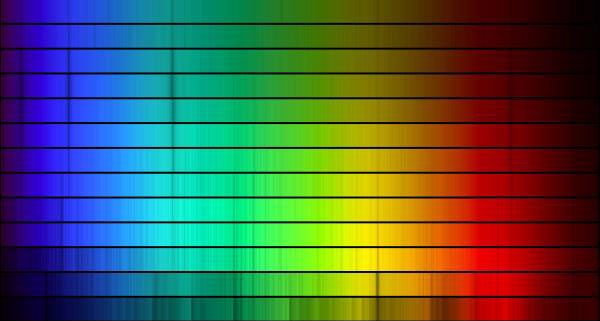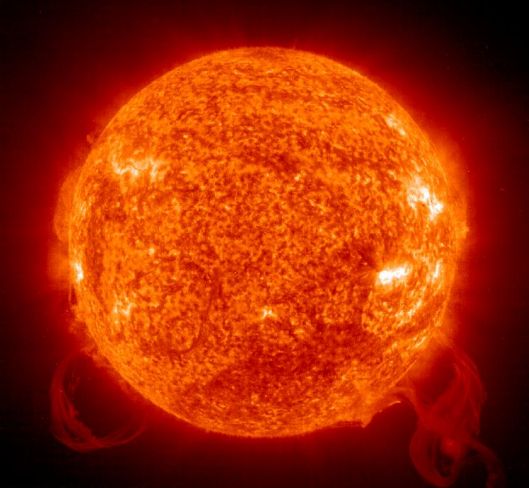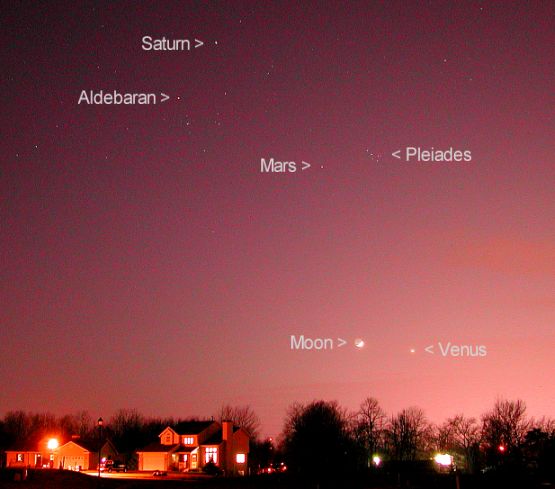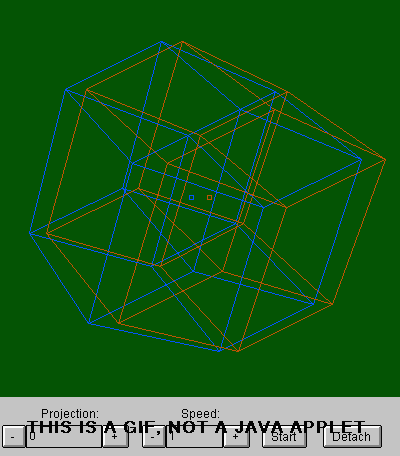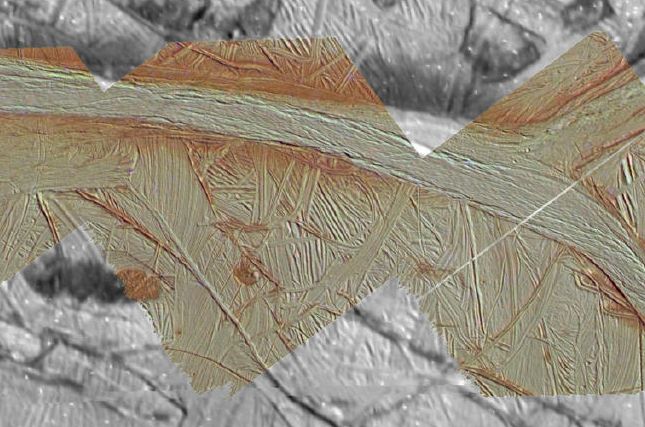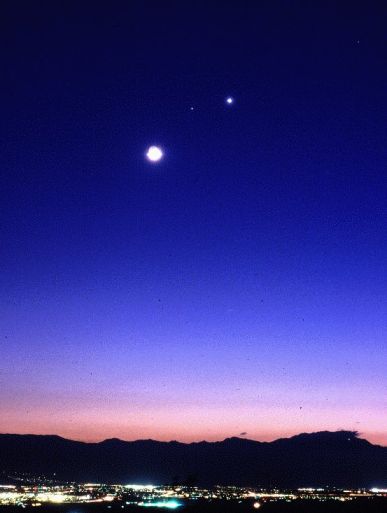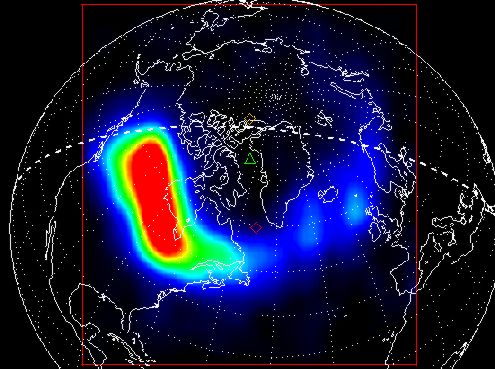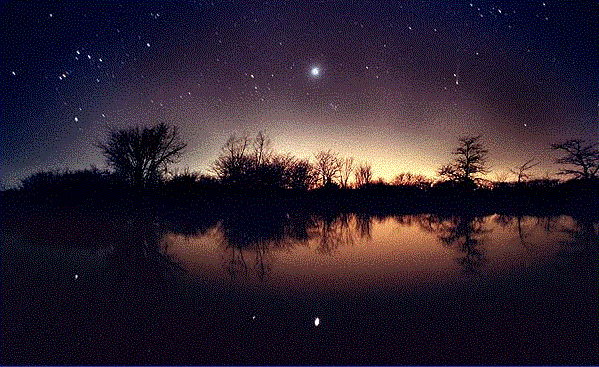| << Previous | Index | Next >> |
2015 One of the largest young craters on Mercury, 114 kilometer (71 mile) diameter Hokusai crater's bright rays are known to extend across much of the planet. But this mosaic of oblique views focuses on Hokusai close up, its sunlit central peaks, terraced crater walls, and frozen sea of impact melt on the crater's floor. The images were captured by the MESSENGER spacecraft. The first to orbit Mercury, since 2011 MESSENGER has conducted scientific explorations, including extensive imaging of the Solar System's innermost planet. Now running out of propellant and unable to counter orbital perturbations caused by the Sun's gravity, MESSENGER is predicted to impact the surface of Mercury on April 30.
2014 This is not a scene from a sci-fi special effects movie. The green beam of light and red lunar disk are real enough, captured in the early morning hours of April 15. Of course, the reddened lunar disk is easy to explain as the image was taken during this week's total lunar eclipse. Immersed in shadow, the eclipsed Moon reflects the dimmed reddened light of all the sunsets and sunrises filtering around the edges of planet Earth, seen in silhouette from a lunar perspective. But the green beam of light really is a laser. Shot from the 3.5-meter telescope at Apache Point Observatory in southern New Mexico, the beam's path is revealed as Earth's atmosphere scatters some of the intense laser light. The laser's target is the Apollo 15 retroreflector, left on the Moon by the astronauts in 1971. By determining the light travel time delay of the returning laser pulse, the experimental team from UC San Diego is able to measure the Earth-Moon distance to millimeter precision and provide a test of General Relativity, Einstein's theory of gravity. Conducting the lunar laser ranging experiment during a total eclipse uses the Earth like a cosmic light switch. With direct sunlight blocked, the reflector's performance is improved over performance when illuminated by sunlight during a normal Full Moon, an effect known as the real Full Moon Curse.
2013
2012 What would it be like to fly a space shuttle? Although the last of NASA's space shuttles has now been retired, it is still fun to contemplate sitting at the controls of one of the humanity's most sophisticated machines. Pictured above is the flight deck of Space Shuttle Endeavour, the youngest shuttle and the second to last ever launched. The numerous panels and displays allowed the computer-controlled orbiter to enter the top of Earth's atmosphere at greater than the speed of sound and -- just thirty minutes later -- land on a runway like an airplane. The retired space shuttles are now being sent to museums, with Endeavour being sent to California Space Center in Los Angeles, California, Atlantis to the Kennedy Space Center Visitor Complex on Merritt Island, Florida, and Discovery to the Udvar-Hazy Annex of the National Air and Space Museum in Chantilly, Virginia. Therefore sitting in a shuttle pilot's chair and personally contemplating the thrill of human space flight may actually be in your future.
2011
[attachment=0]ap110418.jpg[/attachment]
Video not available!
2010 What's happened to our Sun? Last week, it produced one of the largest eruptive prominences ever seen. Pictured above, the prominence erupted in only a few hours and was captured in movie form by NASA's twin Sun-orbiting STEREO satellites. A quiescent solar prominence is a cloud of hot solar gas held above the Sun's surface by the Sun's magnetic field. Unpredictably, however, prominences may erupt, expelling hot gas into the Solar System via a Coronal Mass Ejection (CME). As pictured above, many Earths would easily fit under the expanding ribbon of hot gas. Although somehow related to the Sun's changing magnetic field, the energy mechanism that creates and sustains a Solar prominence is still a topic of research.
2009 NGC 1333 is seen in visible light as a reflection nebula, dominated by bluish hues characteristic of starlight reflected by dust. A mere 1,000 light-years distant toward the heroic constellation Perseus, it lies at the edge of a large, star-forming molecular cloud. This striking close-up view spans about 4 light-years at the estimated distance of NGC 1333. It shows details of the dusty region along with hints of contrasting emission in red jets and glowing gas from recently formed stars. In fact, NGC 1333 contains hundreds of stars less than a million years old, most still hidden from optical telescopes by the pervasive stardust. The chaotic environment may be similar to one in which our own Sun formed over 4.5 billion years ago.
2008 Bright nebulae abound in and around the expansive southern constellation of Centaurus. This one, cataloged as IC 2948/2944 is near the star Lambda Centauri (just off the top of the frame) and not far on the sky from the better known Eta Carinae Nebula. Embedded in the reddish glowing cloud of hydrogen gas, typical of emission nebulae found in massive star-forming regions, is the energetic young star cluster Collinder 249. Seen in silhouette near the top of the view are small, dark clouds of obscuring cosmic dust. Called Thackeray's Globules for their discoverer, they are potential sites for the formation of new stars, but are likely being eroded by the intense radiation from the nearby young stars. Of course, gazing at the center of the region suggests to some IC 2948's popular name - The Running Chicken Nebula. The gorgeous skyscape spans about 70 light-years at the nebula's estimated 6,000 light-year distance.
2007
2006 Appropriately nicknamed "the Skull Nebula", planetary nebula NGC 246 really does surround a dying star some 1,600 light-years away in the constellation Cetus. Expelled over a period of thousands of years, the lovely, intricate nebula is the outer atmosphere of a once sun-like star. The expanding outer atmosphere is interacting with the gas and dust in the interstellar medium, while the star itself, the fainter member of the binary star system seen at the nebula's center, is entering its final phase of evolution, becoming a dense, hot white dwarf. Star and nebula are moving rapidly toward the top of the detailed view, as suggested by the nebula's brighter, upper, leading edge. The sharp image spans just over 2.5 light-years at the estimated distance of NGC 246 and also reveals distant background galaxies, some visible right through the nebula along the bottom.
2005 When can a robot produce art? When it glides past the rings of Saturn. As the robot spacecraft Cassini orbiting Saturn crossed outside the famous photogenic ring plane of the expansive planet, the rings were imaged from the outside, nearly edge on, and in the shadow of Saturn. From the upper left, ring features include the A ring, the Cassini gap, the B ring, and the darker C ring that includes the Titan gap and a gap yet unnamed. Last month when the above image was taken, the gliding spacecraft was about one million kilometers from foreground Enceladus, a small Saturnian moon only about 500 kilometers across. Cassini is scheduled to continue its 70 orbit tour of Saturn over the next three years, sending back images of the gas giant, its rings, and its moons that will be studied for decades to come.
2004 Astronomers divide stars into different spectral types. First started in the 1800s, the spectral type was originally meant to classify the strength of hydrogen absorption lines. A few types that best describe the temperature of the star remain in use today. The seven main spectral types OBAFGKM are shown above with the spectrum of a single "O" star at the top followed by two spectra each from the progressively cooler designations, respectively. Historically, these letters have been remembered with the mnemonic "Oh Be A Fine Girl/Guy Kiss Me." Frequent classroom contests, however, have come up with other more/less politically correct mnemonics such as "Oven Baked Apples From Grandpa's/Grandma's Kitchen. Mmmm." Our Sun has spectral type "G".
2003 Lofted over the Sun on looping magnetic fields, large solar prominences are composed of relatively cool, dense plasma. When seen against the brilliant solar disk they appear as dark filaments, but these enormous magnetic structures are bright themselves when viewed against the blackness of space as they arc above the Sun's edge. In a rare visual treat, these two solar prominences arising from the Sun's southern (lower) hemisphere were captured in extreme ultraviolet light by the EIT camera on board the space-based SOlar and Heliospheric Observatory (SOHO) on March 21. For scale, the pair of plasma loops stretch above the Sun to a height of about twenty times the diameter of planet Earth. In a matter of hours, these prominences apparently erupted away from the Sun's surface and may have been associated with a flare and coronal mass ejection.
2002 Have you seen any bright planets lately? Chances are if you've been outside under clear skies just after sunset, then you have. Now shining in the west as bright "stars" in the night sky, are all five planets of the solar system known to ancient astronomers - Mercury, Venus, Mars, Saturn, and Jupiter. Recorded from Holt, Michigan, USA about 40 minutes after sunset on April 14th, this digital image captures three of them, Venus, Mars, and Saturn, along with a young crescent Moon. Also indicated are the Pleiades star cluster and bright red giant star Aldebaran in Taurus. Mercury, setting, is lost in the trees and glow along the horizon, while Jupiter is off the top of this view. The coming weeks will see photo opportunities galore as all five planets gradually move closer together, posing after sunset with the Moon and stars in the western sky. Venus, Mars, and Saturn will form the closest trio, drawing within a 5 degree circle (about the apparent size of your fist with arm extended) above Aldebaran by May 3rd.
2001 Does our universe have higher but unusual spatial dimensions? This idea has been gaining popularity to help explain why vastly separated parts of our universe appear so similar, and why the geometry of our universe does not seem to result naturally from the amounts of matter it seems to contain. In a new incarnation of an old extra-dimensional idea, some astrophysicists hypothesize that we live in a universe dubbed Ekpyrotic, where our four dimensions (three spatial plus one time) resulted from the fiery collision of two four-dimensional spaces (branes) in a five-dimensional universe. This big-bang hypothesis is meant to compete with another big-bang hypothesis that our universe underwent a superluminal inflation event in the distant past, and does make distinct testable predictions. Above, a dynamic three-dimensional drawing (two spatial plus one time) of a four-dimensional depiction of a five-dimensional cube (a hypercube with four spatial dimensions is also known as a tesseract) is shown. Donning red-blue glasses will give the best multi-dimensional perspective.
2000 This bright white swath cutting across the surface of icy Jovian moon Europa is known as Agenor Linea. In all about 1000 kilometers long and 5 kilometers wide, only a section is pictured here as part of a combined color and black and white image based on data from the Galileo spacecraft. Most linear features on Europa are dark in color but Agenor Linea is uniquely bright for unknown reasons. Also unknown is the origin of the reddish material along the sides. While these and other details of Europa's surface formations remain mysterious, the general results of Galileo's exploration of Europa have supported the idea that an ocean of liquid water lies beneath the cracked and frozen crust. An extraterrestrial liquid ocean holds out the tantalizing possibility of life.
1999 The Moon, Saturn, and Venus shine above while city lights twinkle below in the deepening twilight of March 19. Taken from outside Indio, California, the photo shows the city lights of Indio and nearby Palm Springs. The brilliant lunar crescent is over exposed here with Saturn about 4 degrees away to the upper right and bright Venus still farther to the right only another 2 degrees or so. This Sunday evening, April 18, another dramatic lunar spectacle should be easily visible to stargazers in the western and midwestern US when the crescent moon passes in front of the bright star Aldebaran.
1998 Long ago in a galaxy far, far away, locked in their final desperate struggle against the force of gravity ... two stars exploded! stellar explosions - Supernovae - are among the most powerful events in the Universe, estimated to release an equivalent energy of up to 1 million trillion trillion (1 followed by 30 zeros) megatons of TNT. After the explosion, an expanding supernova envelope is observed to brighten over a a period of days to a maximum light output which rivals that of an entire galaxy before fading from view over the following months. Triggered by the collapsing core of a massive star or the nuclear demise of a white dwarf supernovae occur in average spiral galaxies only about once every 25-100 years. But a recent observation of NGC 664, a spiral galaxy about 300 million light years distant, captured a rare and colorful performance - two supernovae from the same galaxy. In this monitoring exposure the two supernovae, one reddish yellow and one blue, form a close pair just below the image center (to the right of the galaxy nucleus). The color difference is due to temperature - blue is hotter.
1997 On April 7, the SOHO spacecraft spotted a Solar Storm ejecting a cloud of energetic particles toward planet Earth. The plasma cloud's center missed Earth, but high energy particles swept up by Earth's magnetosphere still created a geomagnetic storm! Residents of northerly lattitudes were treated to the spectacle of brilliant aurora as curtains of green and white light danced across the sky. In this image from April 11, the Polar Ionospheric X-ray Imaging Experiment (PIXIE) onboard NASA's orbiting POLAR spacecraft records the strongest X-ray aurora seen in more than a year of operation. The false color image overlaying a map of North America reveals X-rays generated in the upper atmosphere by showers of high energy electrons.
1996 Can you find Comet Hyakutake in the above picture? In this gorgeous photo, the starry night sky of April 9th is pictured with its new comet visitor. In the foreground is a pond with the lights of Kansas City, Missouri on the western horizon. On the upper left, the constellation of Orion is visible. At the center, the brightest object in the picture is the planet Venus. Venus's reflection can be seen in the pond. On the right - halfway between Venus and the photograph's edge - can be seen two bright objects fairly close to each other. Of these two, look closely at lower right object. See the tail? Comet Hyakutake is still visible for Northern observers in the Western sky and now has begun to brighten again as it nears the Sun.
| << Previous | Index | Next >> |
